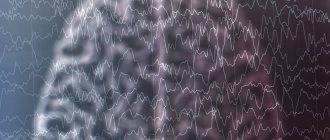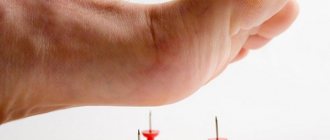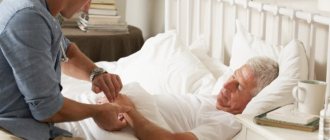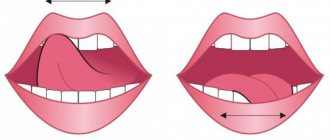For those who are looking for tips on how to easily get rid of this annoying discomfort, which can develop into aching pain in the lower extremities, and also want to quickly cure leg cramps, it is worth reading this article to the end. Here is detailed information on how at home you can independently determine the symptoms of these manifestations and, using the suggested recipes, as well as more effective remedies, cure leg cramps. Such symptoms usually appear in middle and older age. It is worth considering in more detail the main reasons that cause leg cramps, so that later you can avoid exacerbations and prevent this fairly common disease.
Causes of leg cramps
The occurrence of leg cramps is usually observed during periods of intense growth or physical activity, the presence of conditions accompanied by the loss of vitamins and microelements, as well as their increased consumption in the body. To combat a symptom, taking pills is not enough - it may indicate diseases that require full diagnosis and treatment.
Expert opinion!
Frequent leg cramps in the absence of somatic pathology are the first sign of deficiency conditions. Typically, the body lacks potassium, calcium and magnesium, which are responsible for muscle contraction and relaxation. At first, there is heaviness in the legs, it begins to tighten the calves or buttocks, and gradually cramps the leg muscles - thighs, legs, feet and fingers. There is no symmetry - constant cramps occur in the right or left limb, which can only be cured by proper nutrition and taking the necessary medications.
Physiological causes of seizures
When you are tormented by cramps, do not rush to look for chronic diseases. They may be caused by physiological abnormalities. In such conditions, muscle spasms in the legs are temporary.
The most common physiological causes of leg cramps include:
- Heredity - recent research by scientists has proven the presence of genes responsible for a predisposition to muscle spasms, which can only be avoided by following a strict diet,
- Dehydration - with insufficient fluid intake or loss of fluid after a diuretic, electrolytes are lost, which leads to cramps,
- Poor nutrition - if a person eats foods containing little potassium, calcium and magnesium, their deficiency gradually occurs. Muscle function is disrupted, cramps appear,
- A period of intense growth is the root cause of nighttime leg cramps. It is observed in adolescents when the need for microelements exceeds their intake from food,
- Cramps in old age – here occurs the leaching of minerals from the body or insufficient absorption in the intestines. As a result, leg cramps gradually form,
- During pregnancy - while the baby is growing, the mother should eat a balanced diet, study the list of products and know what is missing during cramps. A proper diet will ensure not only the good development of the child, but also prevent deficiency conditions,
- Increased physical activity - cramps after exercise are the first sign of potassium or magnesium deficiency. The symptom usually occurs in the calves or thighs, but may occur in the buttocks or feet,
- Uncomfortable shoes - if the shoes are not the right size, then in the heat or when walking long distances, cramps in the feet or calves may appear. In this condition, blood circulation is impaired, nerves are compressed,
- Medicines - experienced gynecologists know what causes leg cramps in women. Often, uncontrolled use of contraceptives or an error in the selection of the drug leads to the development of spasms,
- Bad habits - many people notice the occurrence of cramps after drinking alcohol. With prolonged use of alcohol, gradual blood poisoning occurs, affecting muscle function,
- Hypothermia - many people are familiar with the condition when their leg cramps in the water. Low temperatures are especially dangerous, leading to vasospasm. The presence of the above reasons increases the risk of symptoms.
Interesting!
The basis of all physiological factors is a violation of the cellular nutrition of muscles. A lack of microelements may be a consequence of a deficiency state, a decrease in their transport through the blood due to damage to blood vessels or nerves.
When seizures are a sign of pathology
Cramps of the lower extremities that occur constantly may be a consequence of a chronic disease. The symptom appears gradually and occurs due to systemic complications of the pathology. To prevent leg cramps, it is necessary to begin treatment of the underlying disease.
Pathological causes of leg muscle spasms include:
- Varicose veins are very dangerous venous congestion in the legs. With insufficient blood outflow, cellular nutrition decreases, lactic acid accumulates, increasing muscle contractility,
- Venous insufficiency - with this pathology, the valves in the vessels are affected, which leads to trophic disorders. Pain occurs, legs pull, spasms gradually develop,
- Heart disease - a lack of minerals in the muscles can occur against the background of circulatory disorders due to heart attacks, myocardial ischemia, rhythm and conduction disorders,
- Anemia - severe cramps occur with a lack of red blood cells and a decrease in the level of hemoglobin in the blood. The muscles “starve”, mineral metabolism disorders occur,
- Convulsions after a stroke - with hemorrhage or ischemia, the cerebral cortex, which is responsible for motor activity, can be affected. In such conditions, consultation with a neurologist is required; conventional supplements and diet are powerless,
- Diabetes mellitus - carbohydrate metabolism disorders can cause leg cramps. In this condition, systemic failures occur, leading to metabolic disorders and the accumulation of lactic acid,
- Diseases of the thyroid gland - this organ is responsible for metabolism, regulates behavioral reactions and the functioning of the nervous system. When it is damaged, systemic complications are noted, one of which is convulsions,
- Epilepsy - with this disease, various types of muscle contractions are observed. In the initial stages, symptoms may be limited to the legs and may be confused with deficiency conditions. Effective treatment will be prescribed by a neurologist after the examination.
On a note!
All pathologies that provoke muscle spasms lead to systemic disorders of the body or brain damage with subsequent disruption of muscle innervation.
To determine the specific cause of seizures, consultation with your doctor is recommended. In most cases, patients themselves know their chronic diseases, which were identified several years ago. The doctor should carefully study the medical history, supplementing the diagnosis with the necessary type of analysis or research method.
Cramps. Physiological prerequisites for the occurrence
Cramps represent a sudden, unintentional and involuntary contraction of striated muscle tissue. The disease begins in the lower extremities and affects the calf muscles located on the back of the lower leg. In most cases, leg cramps are the result of muscle spasms due to a lack of oxygen supply to muscle tissue. For example, with prolonged compression of blood vessels. A disruption in the oxygen supply occurs with a variety of diseases of the circulatory system - medical consultation and urgent treatment are required.
The second common reason for the development of muscle cramps is a lack of nutrients and a number of microelements. People usually don't think about the importance of the food they eat. Food in the digestive tract is broken down into simple components: proteins, fats, carbohydrates and the main part - microelements. Extremely important elements include:
- calcium;
- magnesium;
- potassium;
- vitamins, mainly D and B6.
Leg cramps are primarily a signal from the body about a possible pathology. Don't ignore the condition. One-time convulsive manifestations will not cause concern if numbness is repeated systematically; this is a direct indication to think about your health and make an appointment with a doctor.
- Poor circulation;
- Acute respiratory infection, influenza condition;
- Poisoning – food, toxic, medicinal;
- Dehydration of the body;
- Micronutrient and micronutrient deficiencies;
- Hypothermia of the body and legs separately;
- Phlebeurysm;
- Excessive physical activity;
- Fever;
- Cramps often occur at night and are caused by incorrect body position (in the absence of other symptoms).
Associated symptoms
A seizure is a component of the syndrome, accompanied by characteristic symptoms. For any disease or physiological abnormality, a single clinical picture of several common signs is observed. These include:
- The feeling of discomfort is a kind of “precursor period”. Characterized by heaviness in the legs, numbness, local weakness,
- The pain is of a burning or aching nature, noted at the peak of the attack. Sometimes patients are about or “pulled down”
- Decreased pulse - detected by the doctor during an external examination, determined under the knee. When a leg cramp occurs, the artery is compressed by the hard muscle and impedes blood circulation,
- Change in gait - after an attack, the patient may limp, walk unsteadily, placing the main emphasis on the healthy leg. After a few hours the condition returns to normal,
- Trophic disorders - in the absence of treatment and prolonged progression of the disease, brittle nails, hair loss and the presence of ulcers on the skin are noted. The cause is persistent circulatory problems in the legs.
If seizures develop against the background of chronic pathologies, the accompanying symptoms are accompanied by features of the underlying diseases. With varicose veins, the legs swell, spider veins appear, and with a stroke, there may be clonic spasms.
Rule #1. Learn the correct driving position
The best position—both for safety and for spinal health—is when your neck and back are straight and vertical to the horizontal of the seat (90 degrees is ideal). We don’t throw back our heads or bend them to our knees—you need to look straight ahead, lightly resting the back of your head on the headrest. Lying with your chest on the steering wheel or leaning back too much is not a good idea, as is holding your arms outstretched. The lumbar curve (lordosis) should be directed forward and not tucked back. Remember how you were taught to sit at a desk, and repeat this every day when you sit behind the wheel - within a week, or even earlier, the position will become familiar, and your health will improve.
Features of seizures
In addition to the main symptoms, there may be different severity of symptoms during an attack or before it, depending on certain conditions.
Cramps when walking
They occur predominantly in the flexors - this is the back of the thigh, calf or plantar area. Much less often, spasms are observed on the front surface of the lower leg or above the knee. The cramp appears suddenly, quickly seizes, and releases after a few minutes after a short rest.
Cramp after exercise
The symptom is observed in the most stressed muscles - usually the front, back or inner thighs, and the calf area. Most often, cramps appear the next day, especially in poorly prepared people in the first months of training.
Alcohol seizures
Most often these are seizures of central origin - they affect the whole body, but are weaker than epileptic seizures. The attack can last for several seconds and is often accompanied by loss of consciousness. Sometimes complications arise from the heart and lungs, and there is a risk of injury.
Cramps during pregnancy
Expectant mothers usually experience spasms in the calf muscles and in the foot area. Sometimes contractions can affect other leg muscles. Most often they are disturbed at night or in the morning.
Night cramps
Such spasms indicate a deficiency of microelements, physical overload or age-related changes in the body. Appear in the second half of the night, affecting the calves, soles, back or front of the thigh.
Seizures after stroke
When the cerebral cortex is damaged, contractions involve several muscle groups and can occur on the front and back surfaces of the thigh (shin) simultaneously.
In the elderly
In elderly people, leg cramps appear not only due to a deficiency of microelements, but also due to chronic pathologies. Therefore, there is no clear clinical picture; usually spasms affect the calf muscles and the back of the thigh.
Cramps in the water
Most often during swimming, calf cramps occur - when a swimmer flexes his foot, a muscle spasm occurs. In the presence of concomitant pathologies, contractions of the muscles of the thigh and foot may appear.
On a note!
With any type of cramp, one pattern is observed - spasms are observed in the most loaded leg muscles. Most often these are the calves and hip flexors.
Normal blood pressure in adults: table by age
Blood pressure is a variable parameter that can vary under the influence of many factors - bad weather, severe stress, fatigue, physical activity, etc.
Minor differences do not cause danger; most often, they pass unnoticed by humans. But a persistent increase in blood pressure causes a significant deterioration in the patient’s well-being and can lead to serious complications.
To understand what normal blood pressure is, what blood pressure numbers mean, and what blood pressure is considered elevated, you don’t have to have a medical degree, just be an interested person.
Why do you feed pharmacies if hypertension is afraid of the usual like fire...
Tabakov has revealed a unique remedy against hypertension! To reduce blood pressure while preserving blood vessels, add to…
Human blood pressure
The normal blood pressure for an adult is 120/80. But can such a value be fixed and unchanging if a person is constantly moving and exposed to various factors?
Features of blood pressure indicators:
- If we take into account that all people are different, each has individual characteristics of the body, then blood pressure will still deviate slightly from the norm.
- At the moment, although modern medicine has abandoned the outdated formulas for calculating blood pressure, which previously took into account a person’s gender, weight, height, age, etc. All the same, he often refers to past calculations.
For example, for thin women aged 20-30 years, a blood pressure of 110/70 is considered normal, and if there is a deviation of 20 mmHg, their health will definitely worsen. For athletic men aged 20-30 years, the norm is considered to be a blood pressure of 130/80.
When pressure is measured, indicators are always obtained that mean the following:
- The first indicator is systolic or upper (patients call it cardiac) pressure, which is recorded at the moment of maximum contraction of the heart muscle.
- The second indicator, diastolic or lower (vascular) pressure, is recorded during extreme relaxation of the muscle.
- Pulse pressure indicates the difference between cardiac and vascular pressure (normally 20-30 mm).
Why are normal indicators so important? The fact is that it is precisely the pressure, the norm of which is not exceeded, that is considered ideal for the full functioning of the body and its internal organs, and the risk of developing cardiovascular diseases is reduced.
In addition to blood pressure, the following types of pressure are also distinguished:
- Intracardiac.
- Venous.
- Capillary.
However, all these types of pressure cause difficulties in measuring indicators. Therefore, in almost all cases, with the exception of surgery, blood pressure is measured using the Korotkoff method.
Blood pressure, norms by age
on
As already mentioned above, the norm for an adult aged 20-40 years is considered to be 120/80, this is the value suggested by the medical literature. Normal values between the ages of 16 and 20 will be slightly lower. There is such a thing as working pressure:
- As a rule, it almost never corresponds to the norm, but the person feels excellent and has no complaints.
- This pressure is more relevant for people over 60 years of age who are diagnosed with hypertension.
The diagnosis of arterial hypertension is made when the levels of 140/90 are exceeded at the age of 20-40 years. Many older people over 60 feel great with readings of 150/80.
In this case, there is no need to reduce the pressure. The fact is that with age, atherosclerosis of the vessels of the cerebral hemispheres occurs, and in order to ensure proper blood circulation, higher pressure is necessary.
Another example can be given: young hypotensive people aged 20-30 years live their entire lives with a blood pressure of 95/60, and if their ideal blood pressure reaches 120/80, then all the symptoms of a hypertensive crisis will appear. Blood pressure, norms by age:
- Up to 20 years of age in men 122/79, in women 116/72.
- Up to 30 years of age in men 126/79, in women 120/75.
- 30-40 years old: 129/81 for men, 127/80 for women.
- 40-50 years old: 135/83 for men, 137/84 for women.
- 50-60 years old: 142/85 for men, 144/85 for women.
- 70 years old: men 142/80, women 159/85.
The table clearly shows that until the age of 30-40, women have lower blood pressure than the stronger sex, and from 40 to 70 years of age, blood pressure becomes higher.
However, these are averages based on a person’s age. There are many factors that influence blood pressure readings. A young guy aged 20 and an elderly woman over 60 are equally susceptible to a sharp jump in blood pressure.
Based on medical statistics, we can say that men over 40 who smoke, are overweight and have a history of diabetes are at greater risk. For this age group, constant monitoring of your blood pressure is necessary.
When the pressure is 280/140, a hypertensive crisis occurs, which must be stopped immediately. In this case, you first need to call an ambulance, and before it arrives, try to lower the pressure on your own.
You can measure indicators not only on your hands, but you can measure pressure on your legs. As a rule, the pressure in the legs and arms does not differ by more than 20 mmHg.
If this indicator is exceeded, and the pressure on the legs is greater than on the arms, there is reason to sound the alarm.
Blood pressure in children and adolescents
Blood pressure parameters in children differ from those in adults. Blood pressure increases starting from the birth of a child, then its growth becomes slower, some jumps occur in adolescence, after which the pressure stabilizes as in an adult.
The blood vessels of a newborn baby are elastic, their lumen is wide enough, the network of capillaries is larger, so the normal pressure for him is 60/40. As the child grows and his body develops, blood pressure increases by one year and is 90(100)/40(60).
Recently, arterial hypertension has been diagnosed in children and adolescents:
- Susceptibility to high blood pressure is observed during the period of restructuring of the body.
- Puberty is dangerous because at this time a person is no longer a child, but not yet an adult.
Often at this age, sudden changes in pressure lead to instability of the nervous system. Pathological deviations from the norm must be noticed in time and promptly eliminated. This is the task of parents.
The most common causes of high blood pressure in children and adolescents include:
- Excess weight.
- Children's fears and experiences when a child accumulates them within himself without telling his parents.
- Lack of physical activity, which is typical of almost all modern children, because they are passionate about computer games, and move only in physical education lessons.
- Oxygen starvation of tissues, that is, the child spends very little time in the fresh air.
- Abuse of fatty foods, fast food, chips, sweet soda and other things that children love so much.
- Endocrine disorders.
- Pathological condition of the kidneys.
All of the above circumstances have a detrimental effect on the teenager’s body, therefore, vascular tension increases, the heart functions with greater load, in particular its left side.
If nothing is done, a teenager may reach adulthood with a diagnosis of arterial hypertension or some type of neurocirculatory dystonia.
How to find out your blood pressure?
Every person should know their normal blood pressure parameters, this will help them avoid serious problems in the future. But how can you find out what a person’s blood pressure is?
On the one hand, it seems that there is nothing complicated here: put on the cuff, pump up the air, slowly release it and listen, then record the data.
But, as practice shows, most adult patients, when carrying out the measurement procedure on their own, make many mistakes and, as a result, receive incorrect data.
To get the correct blood pressure numbers, you must follow the following rules:
- Before measuring, you need to be in a calm state for half an hour.
- You should not smoke half an hour before the measurement.
- When taking measurements immediately after eating, the numbers will have larger errors.
- The best position for taking measurements is to sit on a chair and lean your back on its back.
- The arm with the cuff should be at chest level.
- A full bladder increases blood pressure by 7-9 mmHg.
- During the procedure, you cannot move or gesticulate, and talking is also not recommended.
Blood pressure should always be measured on both arms, with secondary measurements taken on the arm where the pressure was higher. If there is too much difference between your hands, this is not normal, you should contact a cardiologist; details on how to measure blood pressure correctly can be found on the pages of our website.
Step-by-step blood pressure measurement with a mechanical tonometer:
- Place the cuff so that it is 3-4 cm above the cubital fossa.
- Place the stethoscope on the inner bend of your elbow and insert it into your ears. At this time, you can hear clear pulse beats.
- Inflate the air to 200-220 mm, then very slowly begin to deflate the air, focusing on the numbers on the tonometer. When deflating, you need to listen to your pulse.
- As soon as the first beat of the pulse is heard, the upper blood pressure must be recorded.
- When the shocks disappear, the lower blood pressure can be recorded.
To find out the pulse pressure, you need to subtract the lower pressure from the upper pressure and get your readings.
The nuances of measuring blood pressure
Scientists have established the fact that when measured using the Korotkov method, the obtained indicators differ by 10% from the real value.
Such an error is compensated by the ease and accessibility of the procedure, and usually everything does not end with one measurement, which allows the error to be reduced to a minimum. Indicators of pressure based on a person’s build:
- Patients do not differ in the same figure; for example, thinner people always have lower blood pressure.
- For people with a dense physique, everything is the opposite, higher than it really is. A cuff wider than 130 mm helps to level out this difference.
- It is worth noting that there are not only overweight people, but there are also diagnoses such as obesity of 3-4 degrees, which makes it difficult to measure on a person’s hand.
- In this option, you need to measure on your leg using a special cuff.
Often the doctor receives false measurements. The fact is that there is such a thing as “white coat syndrome”, when the patient is too worried at a doctor’s appointment, as a result, the tonometer shows higher values than they actually are.
In this case, the doctor prescribes daily monitoring. A cuff is attached to the patient's shoulder and connected to a special mechanism, which injects air at certain intervals and records blood pressure readings.
If it has been noticed that your blood pressure regularly increases, you should consult your doctor; in the early stages of the disease, it is enough to change your lifestyle, as a result of which the pressure will normalize. You can find out what pressure is considered normal and what is elevated in the video in this article.
on
Diagnostics
A spasm is not an independent disease, so the diagnosis will be based on the underlying pathology that caused the spasm. With the first complaints, you should contact a therapist - the doctor will conduct a blood test to identify deficient conditions. If the doctor suspects the presence of a disease, a consultation with one of the following specialists may be prescribed:
- Phlebologist,
- Endocrinologist,
- Neurologist,
- Cardiologist.
CT (computed tomography), MRI (magnetic resonance imaging), ultrasound and x-rays of the lower extremities, brain or abdominal organs will help confirm or refute the presence of the disease.
Rule #2. When choosing a car, pay attention to the quality of the seats
The best seat is anatomical. Not too soft, but not too hard and definitely elastic. The more complete the set of adjustments, the better. Lateral support and lumbar support? - Great! But if the seat is the way it is, a bolster that replaces the lumbar support will help out - there are plenty of them on sale, and they are inexpensive. The roller will help relieve your back. Some drivers use massage seat covers, but they are not suitable for everyone, and in some cases they can cause harm. If you suddenly received such a cape as a gift, read the instructions and read the list of indications and contraindications.
Treatment
Let's look at how and how to treat leg cramps. The main methods used are medications and strengthening procedures in the form of physiotherapy, therapeutic exercises and massage. If desired, you can supplement the therapy with traditional medicine recipes.
Drug therapy
Drug treatment of leg muscle spasms begins with the use of specialized drugs. Before starting it, you should consult a doctor to identify the specific type of deficiency condition:
- When there is a lack of microelements, it is necessary to take products with potassium and magnesium - Panangin, Asparkam, Magnele B6, Magnerot,
- For anemia, iron supplements are indicated - Sorbifer Durules, Aktiferrin,
- If vitamin deficiencies are detected, multivitamins are prescribed - Vitrum, Complivit.
In order to choose a medicine for seizures, you need to consult a doctor. When the doctor determines the nature of the underlying pathology, therapy can be expanded with painkillers, blood thinners and vascular drugs.
Physiotherapy
Treatment of leg cramps can be supplemented with some physical therapy methods. These methods eliminate not the symptom, but the very cause of the underlying disease - providing a general and local effect. The most popular are:
- Medicinal electrophoresis,
- Ion therapy,
- Warm-up sessions
- Magnetotherapy,
- Shock wave therapy.
To obtain a referral, you must contact your attending physician - the doctor determines the approximate number of procedures, periodically monitoring the patient. Sessions are held 2-3 times a week for 15-20 minutes. The first results are observed after a month, provided that all the specialist’s recommendations are followed.
Physiotherapy
With the right approach, you can get rid of leg cramps at home in this way, but to achieve the full effect, you need to supplement the program with massage and observation by your doctor. Gymnastics includes a set of exercises to develop muscles that are subject to spasms:
- If there is a cramp in the legs, it is recommended to walk on tiptoe, swim,
- If you are worried about spasms in the sole area, moderate running, special exercises for your toes,
- Cramps in the hips are treated with special gymnastics and hoop exercises.
Interesting!
For all types of cramps, water procedures have worked well, especially aqua aerobics - but only in warm water and in a specially equipped pool. These exercises do not overload the muscles, improve blood flow and cellular nutrition.
Massage
The purpose of massage has a very beneficial effect on the condition of the muscles. The best option is to warm up your calves and soles. This treatment can be done at home, but it is better to consult a professional. If its duration is 20 minutes or more, the effect of such procedures is observed after 2-3 weeks. Sessions should be attended every other day, alternating them with therapeutic exercises.
ethnoscience
Recipes from traditional healers will perfectly complement the treatment of leg cramps. Mostly medicinal herbs, rubs or compresses are used. Popular recipes:
- Rubbing with spices - red pepper or ginger is suitable, which should be rubbed into the skin of the problem area. Returns sensitivity, improves blood flow,
- A useful tincture - take chamomile petals and brew with boiling water. You should drink this tea three times a day, before meals,
- Therapeutic bath – the most popular is sea salt. Ablution is performed for 15-20 minutes,
- Compresses with vegetables - cabbage leaves, raw potatoes or beets, cut into slices, are suitable.
All traditional medicine recipes are symptomatic treatment - they eliminate symptoms to make the patient feel better. That is why consultation with a doctor is advisable. If you want to fight seizures using such methods, contact your doctor and listen to his opinion on the effectiveness of specific home recipes.
Folk remedies
Caraway tincture is very helpful in the fight against cramps. To prepare it you will need one tablespoon of cumin fruits, two tablespoons of mint, and one tablespoon each of anise and fennel, mix all these ingredients, pour boiling water, leave for about an hour. Drink in small glasses throughout the day. You need to eat right and normalize your daily diet. It is important to divide all writing techniques into at least five times. This will help you avoid gaining excess weight, which will significantly reduce the occurrence of cramps. On a regular basis, you should take foot baths based on sea salt. A warm bath will help relax the leg muscles; after completing this procedure, you need to wrap your legs in warmth and lie down to rest. During the period of illness, it is best to avoid high-heeled shoes.
Prevention
There is no specific prevention of seizures, but you can follow some rules to reduce the likelihood of their occurrence. Clinicians offer the following advice to patients at risk:
- Choose comfortable shoes that do not restrict movement,
- Eat a diet that includes potassium, magnesium and calcium foods. You can get a useful table from your doctor,
- Twice a week - massage and therapeutic exercises,
- Lead an active lifestyle
- Give up bad habits
- Visit your doctor regularly.
Compliance with these preventive measures is indicated for all patients with a genetic predisposition, athletes, the elderly and pregnant women, as well as persons with chronic pathologies.
Leg cramps occur with a deficiency of microelements, circulatory disorders, as well as local and systemic diseases. If spasms appear, it is advisable to consult a doctor - therapy from the first days is more effective, and the prognosis is more favorable.
What to do if your leg cramps
There are some current tips on what to do when you have leg cramps. You need to do the following:
- Perform an intensive massage of the tense area.
- Apply a cold compress.
- First aid for leg cramps is to stretch the affected area:
- feet, calves: while sitting, straighten your lower limbs, pull your big toes towards you;
- anterior femoral part: standing, bend the limb at the knee, clasp the ankle with your hands, pull the foot towards the buttocks;
- back of the thighs: put the affected leg forward, place it on the heel, bend the other limb at the knee and lean on it with your hands, carefully stretch the contracted limb, moving the pelvic part back.
Symptoms and mechanism of development
A foot cramp is a sudden, uncontrollable contraction of a leg muscle. Most often, tonic spasms are observed, which cause physiological causes not related to the development of a systemic disease. The share of epileptic seizures of the feet accounts for only 3-5%.
To provide movement, the brain sends neural impulses to the limbs and muscle contraction occurs. To ensure normal conduction of nerve endings, it is necessary to receive beneficial vitamins and microelements - potassium, calcium, magnesium. With a deficiency of these minerals, the innervation of the foot is disrupted and cramps occur.
Beneficial substances come from food and are carried to soft tissues through the bloodstream. Both endogenous and exogenous factors can disrupt the vitamin-mineral balance and provoke leg muscle cramps. Typically, foot cramps develop against the background of slow blood circulation, as a result of which the muscles do not receive enough oxygen and nutrients.
Expert opinion!
If cramps in the feet occur rarely and go away on their own within 1-2 minutes, there is no need to worry. Such spasms do not pose a threat to health. But when the muscles of the foot often cramp, the attacks become longer and are accompanied by severe pain, you should seek medical help and undergo a comprehensive examination to identify the causes of this condition.












